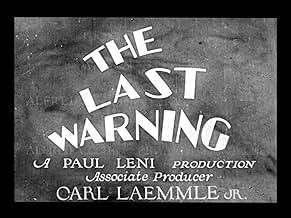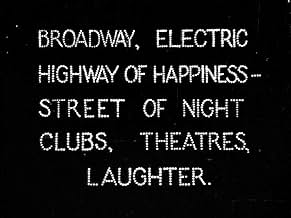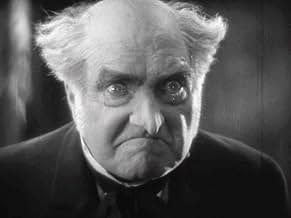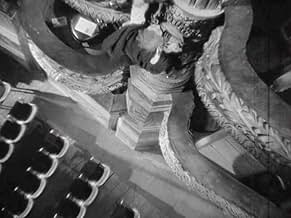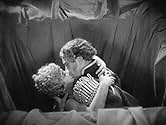Agrega una trama en tu idiomaA producer decides to reopen a theater, that had been closed five years previously when one of the actors was murdered during a performance, by staging a production of the same play with the... Leer todoA producer decides to reopen a theater, that had been closed five years previously when one of the actors was murdered during a performance, by staging a production of the same play with the remaining members of the original cast.A producer decides to reopen a theater, that had been closed five years previously when one of the actors was murdered during a performance, by staging a production of the same play with the remaining members of the original cast.
- Dirección
- Guionistas
- Elenco
Carrie Daumery
- Barbara Morgan
- (as Mme. Carrie Daumery)
Slim Summerville
- Tommy Wall
- (as 'Slim' Summerville)
Bud Phelps
- Sammy
- (as 'Buddy' Phelps)
Charles K. French
- Doctor
- (sin créditos)
Pat Harmon
- Cop
- (sin créditos)
Francisco Marán
- Jeffries
- (sin créditos)
Opiniones destacadas
"The Last Warning" (1928) was Paul Leni's last film as director before his untimely death from sepsis at the age of 44. Starring Laura La Plante, Montague Love, John Boles, Margaret Livingston, Roy D'Arcy, and a host of other pre-eminent silent film actors of the day, this film continues in the vein of "The Cat and the Canary" (1927), another Leni film starring Laura La Plante. Based on a successful 1922 play, the film opens on a stage play where John Woodford (D'Arcy Corrigan) is on stage reaching for a candle, but dies as the mechanical candle electrocutes Woodford. Now, the play is halted, police called in, and, after a series of several hectic and quickly moved-through scenes, the body disappears, never to be seen again. Five years later, a "producer", Montague Love, decides to re-open the theater - which had been closed in the interim - and re-stage the same play Woodford had been killed performing in, and now have the same cast perform the play for the re-opening of the theater. Roy D'Arcy will replace Woodford in that part and John Boles will replace D'Arcy in his old part. Well, D'Arcy is nearly electrocuted during a rehearsal; then seemingly disappears! Boles replaces D'Arcy, and the play opens that night! Near the scene where the candle is to be reached for and grabbed, the police - a group of at least 10 and perhaps a couple of unsuspected persons who might be the police - are ready for anything.
The photography; that is, the movement of the camera, what it captures and how, is how Leni made his reputation. He'd done remarkable things with films like "Hintertreppe" (1921), "Waxworks" (1924) and "The Man Who Laughs" (1928). Hal Mohr was Leni's cinematographer on this shoot, and the fluidity and creative shooting is what makes this film a cinematic masterpiece. The story is rather "old dark house", and it's fun, with comic touches and dramatic incident, but it's the deft direction and smart editing, along with a cast of pros, that makes this film something to enjoy and wish to come back to in the future.
There were a few sound scenes added to the original release that are no longer extant. The restored version is quite good, though a few scratches here and there, especially near the beginning and end, are evident. My print is the European restored one from Eureka Masters of Cinema. I needed to re-set my Blu-Ray to Region 2 to play it. It didn't do it automatically.
The opening and closing scenes have been described as 'kaleidoscopic', and that is a perfect description. Wonderful cinematography and editing throughout make this a wonderful experience over 90 years after release! Highly recommended. Among others in the remarkable cast are Burr McIntosh, Bert Roach, Mack Swain, Slim Summerville, and Carrie Daumery.
The photography; that is, the movement of the camera, what it captures and how, is how Leni made his reputation. He'd done remarkable things with films like "Hintertreppe" (1921), "Waxworks" (1924) and "The Man Who Laughs" (1928). Hal Mohr was Leni's cinematographer on this shoot, and the fluidity and creative shooting is what makes this film a cinematic masterpiece. The story is rather "old dark house", and it's fun, with comic touches and dramatic incident, but it's the deft direction and smart editing, along with a cast of pros, that makes this film something to enjoy and wish to come back to in the future.
There were a few sound scenes added to the original release that are no longer extant. The restored version is quite good, though a few scratches here and there, especially near the beginning and end, are evident. My print is the European restored one from Eureka Masters of Cinema. I needed to re-set my Blu-Ray to Region 2 to play it. It didn't do it automatically.
The opening and closing scenes have been described as 'kaleidoscopic', and that is a perfect description. Wonderful cinematography and editing throughout make this a wonderful experience over 90 years after release! Highly recommended. Among others in the remarkable cast are Burr McIntosh, Bert Roach, Mack Swain, Slim Summerville, and Carrie Daumery.
German director Paul Leni (1885-1929), almost a century after his death, is finally getting the recognition he deserves. His 4 most important films are now available on home video with the last two in quality Blu-Ray/DVD editions from Flicker Alley. For the record the films are 1) WAXWORKS (made in Germany in 1924) and the 3 surviving Hollywood films, THE CAT AND THE CANARY (1927), THE MAN WHO LAUGHS (1928), and THE LAST WARNING (1929). A fourth Hollywood film, the early Charlie Chan mystery THE CHINESE PARROT, is still considered lost.
While these movies had been around awhile for people to see, they were usually in substandard, low budget VHS editions. With the dawn of the 21st century came DVD versions of the first 3 films which allowed these movies to be viewed as they should be with restored visuals, correct running speed, and a proper soundtrack. This confirmed what only still photos had shown before, that Leni was a master of settings, lighting, and cinematography and provided the blueprint for the classic Universal horror films of the 1930s.
THE LAST WARNING was meant to cash in on the huge success of THE CAT AND THE CANARY. Instead of an old dark house, it's an old dark theater which gives Leni the opportunity to indulge in a number of stylistic tricks borrowed from German Expressionism and especially F. W. Murnau. 2 of the performers, Montague Love and Mack Swain, even bear a striking resemblance to Emil Jannings. Laura La Plante is back as the heroine along with a masked killer whose identity is not revealed until the final 10 minutes.
THE LAST WARNING's weakest element is its storyline. It's a pretty good mystery until the final revelation which really doesn't make a whole lot of sense but then its the visual flair that matters the most to us today. Thanks to Universal's new 4K restoration that flair positively jumps out at us from the film's opening Broadway montage to the finale shot from the killer's POV as he swings on a rope. The restoration is a composite print taken from 2 different sources. There are a few rough places but overall it looks great for a 90 year old film.
It takes more than a visual restoration to make a silent film successful. It also needs a music score to accompany the visuals in such a way as to enhance them. In the previous two reviews for this release, one reviewer loved the score while the other positively hated it. While I agree with the latter that the Flicker Alley Mary Pickford scores are rather inappropriate, I lean more toward the former in that, while not finding the score as great as he says, I found nothing objectionable as this movie is light entertainment not a heavy drama.
In summary I find this, along with FA's simultaneous release of Paul Leni's THE MAN WHO LAUGHS, to be another triumph for Flicker Alley. In addition to the best looking prints that we have ever seen, both releases come with numerous extras including a short video documentary on director Leni along with a 24 page booklet full of photos and background info. Now if FA can only persuade Universal to do a 4K restoration on the the original 1925 release of THE PHANTOM OF THE OPERA, the Universal silent horror collection would be complete...For more reviews visit The Capsule Critic.
While these movies had been around awhile for people to see, they were usually in substandard, low budget VHS editions. With the dawn of the 21st century came DVD versions of the first 3 films which allowed these movies to be viewed as they should be with restored visuals, correct running speed, and a proper soundtrack. This confirmed what only still photos had shown before, that Leni was a master of settings, lighting, and cinematography and provided the blueprint for the classic Universal horror films of the 1930s.
THE LAST WARNING was meant to cash in on the huge success of THE CAT AND THE CANARY. Instead of an old dark house, it's an old dark theater which gives Leni the opportunity to indulge in a number of stylistic tricks borrowed from German Expressionism and especially F. W. Murnau. 2 of the performers, Montague Love and Mack Swain, even bear a striking resemblance to Emil Jannings. Laura La Plante is back as the heroine along with a masked killer whose identity is not revealed until the final 10 minutes.
THE LAST WARNING's weakest element is its storyline. It's a pretty good mystery until the final revelation which really doesn't make a whole lot of sense but then its the visual flair that matters the most to us today. Thanks to Universal's new 4K restoration that flair positively jumps out at us from the film's opening Broadway montage to the finale shot from the killer's POV as he swings on a rope. The restoration is a composite print taken from 2 different sources. There are a few rough places but overall it looks great for a 90 year old film.
It takes more than a visual restoration to make a silent film successful. It also needs a music score to accompany the visuals in such a way as to enhance them. In the previous two reviews for this release, one reviewer loved the score while the other positively hated it. While I agree with the latter that the Flicker Alley Mary Pickford scores are rather inappropriate, I lean more toward the former in that, while not finding the score as great as he says, I found nothing objectionable as this movie is light entertainment not a heavy drama.
In summary I find this, along with FA's simultaneous release of Paul Leni's THE MAN WHO LAUGHS, to be another triumph for Flicker Alley. In addition to the best looking prints that we have ever seen, both releases come with numerous extras including a short video documentary on director Leni along with a 24 page booklet full of photos and background info. Now if FA can only persuade Universal to do a 4K restoration on the the original 1925 release of THE PHANTOM OF THE OPERA, the Universal silent horror collection would be complete...For more reviews visit The Capsule Critic.
"The Cat and the Canary" (1927) must've been a popular entry in what was already a crowded field of old-dark-house horror comedies in the final years of the silent era. One need look no further for evidence of that fact than this followup film, "The Last Warning," which reunited director Paul Leni and star Laura Le Plante, as well as a couple of the same writers and art director, for a similar spooky murder mystery with the slight novelty that it's set in a theatre this time. Moreover, the next year, following Leni's death, Universal released a talkie remake of "The Cat and the Canary," the now-lost "The Cat Creeps" (1930). (Likewise, "The Last Warning" was later remade as "The House of Fear" (1939), which is the title of the book from which the play and, thus, the films were derived.) Although Leni's two films were based on different plays, it seems that many of these narratives tended to be strikingly similar, with perhaps the stage version of "The Bat" being the originator of the formula, which itself was made twice for the screen by Roland West ("The Bat" (1926) and "The Bat Whispers" (1930)). The other successful Universal property that "The Last Warning" clearly borrows from is "The Phantom of the Opera" (1925) by reusing its auditorium set, and like Gaston Leroux's story, the stage setting of "The Last Warning" features a play-within-a-play structure--offering a self-reflexive twist on the familiar old-dark-house formula.
Personally, although I've been reviewing quite a few of these films lately, I'm not a fan of the formula--at least not until James Whale introduced a more campy sense of humor and more twisted subject matter with "The Old Dark House" (1932). Before that, they tended to be exceedingly silly, relying on characters' fear of ghosts, and the mysteries are hardly interesting, if not appallingly convoluted. That of "The Last Warning" is especially of little concern, with nary a clue offered throughout the proceedings before an intricate resolution clumsily ties everything together in the end. The main point of the construction, though, was to replay the antics of the 1927 film. So, once again, there's a whodunit, the body of which disappears, and a group of suspects are brought together under one roof, where they're excessively scared that a ghost is behind all of the horrors. As in "The Bat" and "The Cat and the Canary," there's a masked menace creeping through hidden passages haunting the place. By employing "The Phantom of the Opera" set, the similarity between these haunted house plays to Leroux's story becomes blatant, as well, with both featuring a masked menace terrorizing its occupants. Unlike Leroux's Phantom, however, this one has no Christine, but rather insists that no play be performed at all.
Like "The Cat and the Canary," Leni's style here goes a long way in at least making them visually appealing. The superimpositions, including kaleidoscopic images, the moving title effects and moving-camera shots stand out. Originally, there were also sound effects and dialogue scenes, making this late silent film a goat gland and offering the additional technical marvelry of sound. More interesting, though, and why I like this a bit more than "The Cat and the Canary" and most of the other early old dark houses is the honesty of the self-reference of how shamelessly this film imitates its predecessors. In it, the same cast and crew are brought back together to perform the same play they performed years ago, when the original murder occurred, and this is essentially what Leni and the rest of the Universal staff were doing in making the film--bringing back the same cast and crew to perform basically the same play they performed years ago. Even where the cast isn't exactly the same in the two films, the different actors mimic some of the same types of the prior one--so much so that I initially thought that at least a couple others besides Le Plante had appeared in "The Cat and the Canary" as well. Appropriately, the play-within-the-play is titled "The Snare," the play itself being a snare to uncover the murderer in the narrative. In fact, the most we ever get of the inner play is from the point-of-views of the producer and stage hands as spectators of the culprit being lured in by their ruse, and not of the actual play performed for the theatre audience, whose perspectives we don't share. But, the real snare is the trap set by the filmmakers to lure audiences back for the same film in a new guise.
(Note: The reduction prints out there for home viewing are horrendous, but there is a restored version that has appeared at festivals. Hopefully, it'll receive a home video release someday like its companion piece, "The Cat and the Canary.")
Personally, although I've been reviewing quite a few of these films lately, I'm not a fan of the formula--at least not until James Whale introduced a more campy sense of humor and more twisted subject matter with "The Old Dark House" (1932). Before that, they tended to be exceedingly silly, relying on characters' fear of ghosts, and the mysteries are hardly interesting, if not appallingly convoluted. That of "The Last Warning" is especially of little concern, with nary a clue offered throughout the proceedings before an intricate resolution clumsily ties everything together in the end. The main point of the construction, though, was to replay the antics of the 1927 film. So, once again, there's a whodunit, the body of which disappears, and a group of suspects are brought together under one roof, where they're excessively scared that a ghost is behind all of the horrors. As in "The Bat" and "The Cat and the Canary," there's a masked menace creeping through hidden passages haunting the place. By employing "The Phantom of the Opera" set, the similarity between these haunted house plays to Leroux's story becomes blatant, as well, with both featuring a masked menace terrorizing its occupants. Unlike Leroux's Phantom, however, this one has no Christine, but rather insists that no play be performed at all.
Like "The Cat and the Canary," Leni's style here goes a long way in at least making them visually appealing. The superimpositions, including kaleidoscopic images, the moving title effects and moving-camera shots stand out. Originally, there were also sound effects and dialogue scenes, making this late silent film a goat gland and offering the additional technical marvelry of sound. More interesting, though, and why I like this a bit more than "The Cat and the Canary" and most of the other early old dark houses is the honesty of the self-reference of how shamelessly this film imitates its predecessors. In it, the same cast and crew are brought back together to perform the same play they performed years ago, when the original murder occurred, and this is essentially what Leni and the rest of the Universal staff were doing in making the film--bringing back the same cast and crew to perform basically the same play they performed years ago. Even where the cast isn't exactly the same in the two films, the different actors mimic some of the same types of the prior one--so much so that I initially thought that at least a couple others besides Le Plante had appeared in "The Cat and the Canary" as well. Appropriately, the play-within-the-play is titled "The Snare," the play itself being a snare to uncover the murderer in the narrative. In fact, the most we ever get of the inner play is from the point-of-views of the producer and stage hands as spectators of the culprit being lured in by their ruse, and not of the actual play performed for the theatre audience, whose perspectives we don't share. But, the real snare is the trap set by the filmmakers to lure audiences back for the same film in a new guise.
(Note: The reduction prints out there for home viewing are horrendous, but there is a restored version that has appeared at festivals. Hopefully, it'll receive a home video release someday like its companion piece, "The Cat and the Canary.")
Essentially this is part "Cat and the Canary" and part "Phantom of the Opera" - also silent Universal properties. It has some slack parts but the visual atmosphere helps to cover them up, and it has some very inventive title cards where the writing may be initially blurry and come into focus, or the writing may start up clear and then appear to melt down the page, or it may appear to be underwater.
The film is about an actor, John Woodford, in a theatre on Broadway, who dies suddenly when he gets to the part of the play where he is backed into the fireplace by another actor and picks up a candlestick. The lights go out, and when they come back on there is Woodford dead on the floor. The police come to question everybody who was present, then Woodford's body disappears before the coroner gets there. It is discovered by the police that Woodford and another actor, Richard Quayle (John Boles) were arguing in actress Doris Terry's (Laura LaPlante's) dressing room, and both were suitors of hers.
So without a body, the investigation cannot go on, the theatre is closed, and the papers are shown having a field day with the "love triangle" that is insinuated to have something to do with the killing. Several years later, Woodford's close friend (Montagu Love as Arthur McHugh) decides to reopen the theatre with the same cast as the night of the killing and the same play. Why does the entire cast return? Because to not return would make them look guilty.
But somebody does not want the play to open. Heavy scenery comes crashing down. Smoke bombs go off. Threatening letters are written to members of the cast that they perform at their peril, and some mysterious masked figure is running and jumping about the place and even stealing Doris' purse and putting her personal possessions in strategic places to make her look like she is in on all of the strange happenings. Is it the ghost of John Woodford trying to avenge himself? Well of course not. But it might be the real John Woodford, having faked his own death, and still mad at Boles and LaPlante for his romantic rejection. Watch and find out what is behind all of this.
The visuals are just great here. The opening scene reminds me somewhat of 1929's Broadway with all of the pictures of the Broadway nightlife of 1929. Also, the theatre, from the outside, looks like the face of some frightening creature complete with eyes, a nose, and mouth. I just wish better prints were available.
The film is about an actor, John Woodford, in a theatre on Broadway, who dies suddenly when he gets to the part of the play where he is backed into the fireplace by another actor and picks up a candlestick. The lights go out, and when they come back on there is Woodford dead on the floor. The police come to question everybody who was present, then Woodford's body disappears before the coroner gets there. It is discovered by the police that Woodford and another actor, Richard Quayle (John Boles) were arguing in actress Doris Terry's (Laura LaPlante's) dressing room, and both were suitors of hers.
So without a body, the investigation cannot go on, the theatre is closed, and the papers are shown having a field day with the "love triangle" that is insinuated to have something to do with the killing. Several years later, Woodford's close friend (Montagu Love as Arthur McHugh) decides to reopen the theatre with the same cast as the night of the killing and the same play. Why does the entire cast return? Because to not return would make them look guilty.
But somebody does not want the play to open. Heavy scenery comes crashing down. Smoke bombs go off. Threatening letters are written to members of the cast that they perform at their peril, and some mysterious masked figure is running and jumping about the place and even stealing Doris' purse and putting her personal possessions in strategic places to make her look like she is in on all of the strange happenings. Is it the ghost of John Woodford trying to avenge himself? Well of course not. But it might be the real John Woodford, having faked his own death, and still mad at Boles and LaPlante for his romantic rejection. Watch and find out what is behind all of this.
The visuals are just great here. The opening scene reminds me somewhat of 1929's Broadway with all of the pictures of the Broadway nightlife of 1929. Also, the theatre, from the outside, looks like the face of some frightening creature complete with eyes, a nose, and mouth. I just wish better prints were available.
This dazzling example of late silent cinema was available only in shoddy, awful looking prints for 80 years or more, until it was restored in 2016 and finally released on home video in 2019, and now for the most part looks fantastic. It was the final film made by the great Paul Leni, whose magnificent "The Man Who Laughs" is one of the absolutely essential silent works everyone needs to see at least once before they die.
The story of this one is a cross between The Cat And The Canary and The Phantom of The Opera, but not really as good as either: an actor is killed onstage and everyone in the cast and crew becomes a suspect; the theatre closes for years until the play is revived, and the killer plans to kill all over again. There's secret passageways and cobwebs galore, and a decent enough mystery, but it's got to be said the plot's a little messy and hard to follow at times.
It's in the visuals that The Last Warning really shines, with the camera in every scene swooping and zooming in on every action taking place, and great use of depth of field to draw one's eyes to things happening in the background: the camera is always doing something, always telling us something about the story and the characters, purely through visual means. This is the very peak of what silent cinema was reaching for at the end of the 1920s, just before the talkies came in the following year and largely destroyed that artform and the box of tricks it used for everyone but Alfred Hitchcock, at least until Citizen Kane came along. I always like to imagine what might have happened if sound had not been introduced for another 15 or twenty years; what visual magic and ways of imparting story through image might have been achieved.
In summation, then: not the most compelling or meaningful story but one full of energy, movement and endless inventiveness. A great delight for the eyes.
7½/10.
The story of this one is a cross between The Cat And The Canary and The Phantom of The Opera, but not really as good as either: an actor is killed onstage and everyone in the cast and crew becomes a suspect; the theatre closes for years until the play is revived, and the killer plans to kill all over again. There's secret passageways and cobwebs galore, and a decent enough mystery, but it's got to be said the plot's a little messy and hard to follow at times.
It's in the visuals that The Last Warning really shines, with the camera in every scene swooping and zooming in on every action taking place, and great use of depth of field to draw one's eyes to things happening in the background: the camera is always doing something, always telling us something about the story and the characters, purely through visual means. This is the very peak of what silent cinema was reaching for at the end of the 1920s, just before the talkies came in the following year and largely destroyed that artform and the box of tricks it used for everyone but Alfred Hitchcock, at least until Citizen Kane came along. I always like to imagine what might have happened if sound had not been introduced for another 15 or twenty years; what visual magic and ways of imparting story through image might have been achieved.
In summation, then: not the most compelling or meaningful story but one full of energy, movement and endless inventiveness. A great delight for the eyes.
7½/10.
¿Sabías que…?
- TriviaSets from El fantasma de la ópera (1925) used.
- ConexionesFeatured in Universal Horror (1998)
Selecciones populares
Inicia sesión para calificar y agrega a la lista de videos para obtener recomendaciones personalizadas
- How long is The Last Warning?Con tecnología de Alexa
Detalles
- Fecha de lanzamiento
- País de origen
- Idioma
- También se conoce como
- Sista varningen
- Locaciones de filmación
- Productoras
- Ver más créditos de la compañía en IMDbPro
- Tiempo de ejecución1 hora 29 minutos
- Color
- Mezcla de sonido
Contribuir a esta página
Sugiere una edición o agrega el contenido que falta

Principales brechas de datos
By what name was The Last Warning (1928) officially released in India in English?
Responda

